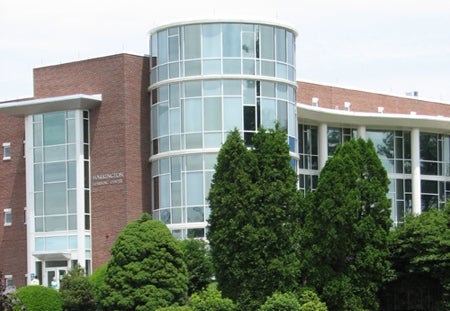Since fiscal year 2008, state funding for Quinsigamond Community College in Worcester has declined by nearly 16 percent from about $15.1 million to a $12.7 million allocation for fiscal year 2010.
Meanwhile, enrollment has skyrocketed about 25 percent in the same time period.
“Despite the cutback in state funding, we haven’t been able to cut back here,” said Gail Carberry, QCC’s president. “Our services are in high demand, and so we need to provide them.”
And when colleges and universities face a budget crunch, it’s normally the students who end up footing the bill.
Quinsigamond students will pay about 4 percent more for classes next year, from $152 per credit hour to $158 per credit hour beginning this fall.
It’s a trend happening at colleges and universities across Central Massachusetts, according to data compiled by the Worcester Business Journal. Increases range from the modest to the steep, with state schools, which are the most affordable, facing the sharpest percent increases.
Take Worcester State, for example. Like many public colleges, it is expecting decreased funding from the state again next fiscal year. To help make up that gap, Worcester State’s board of trustees approved a $550 increase to fees, which will bring tuition and fees to $7,155 for full-time commute students and $14,733 for the average residential student.
State Support
For public institutions, fee increases are inversely related to state funding support, according to Frederick Clark, executive officer for the Council of Presidents, a state group that coordinates issues among the state’s nine public colleges.
“Even with fee increases, it is not making up the total that has been withdrawn from state funds,” he said.
According to the council’s annual college affordability report, which was released in February, Massachusetts has cut funding for public higher education more than any other state in the country during the last five years. It’s down to 1998 funding levels, he said. During the last two years, only Alabama has cut more from higher education funding.
The increased cost of public higher education is normalizing the price distinction between public and private institutions, according to Richard Freeland, commissioner of the state Department of Higher Education.
“We’re facing a fundamental change in the social contract for education,” Freeland said.
According to the College Board’s annual college affordability survey, prices at public colleges and universities rose at an average annual rate of 4.9 percent between 2000 and 2010, which outpaced the rate of increase in either of the preceding two decades.
Furthermore, perhaps the worst has yet to come.
Federal stimulus dollars for higher education will be tapped out by next fiscal year, leaving almost none remaining for fiscal year 2012.
“Next year (FY2012), we’re in trouble,” said Fitchburg State College President Robert Antonucci.
Fitchburg State received about $5 million in stimulus funds last year and is slated to get about $1.3 million in stimulus funds in fiscal year 2011.
Even with the stimulus support, the college is expecting to raise fees a maximum of 8.4 percent to as high as $16,050 depending on how much money is supplied in the state budget.
The Senate, House and Governor’s versions of the budget each have separate funding amounts for state colleges.
But, Antonucci said while he’s concerned about the “funding cliff” in 2012, the priority is to get through this year. Improvements in the state’s economy could increase tax revenue collections, which could return state funding levels to pre-recession amounts.
“It’s a wait and see,” he said.
The University of Massachusetts is facing similar challenges related to stimulus funds. Last year the trustees approved a $1,500 fee increase for undergraduate student, but stimulus funds offset $1,100 of the amount for each student.
This year, with less stimulus funds available, the school is implementing the $1,500 fee increase in full.
In-state students at UMass Medical School in Worcester, however, did not receive any of those stimulus rebates, so their tuition and fees will remain level next academic year. First and second-year non-resident medical school students will see cost increases totaling about 2.4 percent to $48,008.
Private Perspective
Public colleges aren’t the only ones looking to increase tuition and fees next year.
Anna Maria College in Paxton will increase tuition and fees by 5.9 percent from $26,620 to $28,204. Room and board will also increase from $9,630 to $10,202. College President Jack Calareso said part of the reason tuition is rising higher and higher each year is because college admissions have become increasingly competitive.
“There are expectations that every institution have the same resources to offer students,” he said. “So, if college X has a climbing wall, college Y thinks it needs a climbing wall. What we’re all trying to do is become the Cheesecake Factory of colleges and offer students as many choices as possible.”
Other colleges points to regular business expenses increasing. And college CFOs are doing everything they can to hold off the increases.
Assumption College in Worcester, for example, is raising tuition by about 3.8 percent to $30,940 from $29,806.
To help control costs, the college renegotiated its food service contract with provider Sodexho through a competitive bidding process.
The college entertained offers from multiple vendors and settled on a deal that will allow food costs for students to remain steady next year.
The college is also switching to less-expensive heating oil.
“We’re making a very conscious effort to do everything we can to mitigate the cost of private college education, recognizing the students and their families have a lot of choices when it comes to picking an education, so we are just trying to make the cost of our education the most attractive it can be,” said Christian McCarthy, executive vice president for finance and administration for Assumption.
Even with all the efforts to contain the costs, the college is still facing health-care costs rising by double digits and municipal tax fees rising.
“Those are just costs that are out of our control,” he said.

